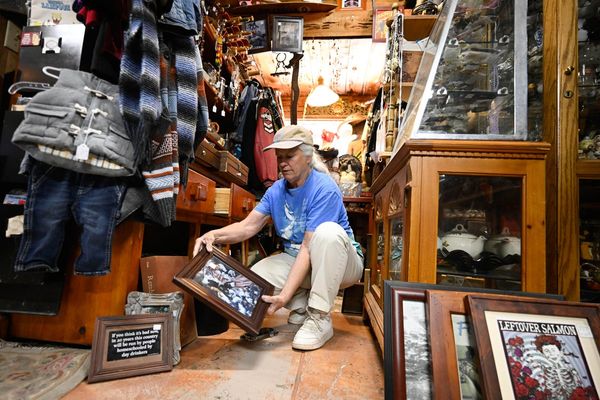The peregrine falcon looks set to hit another milestone in its unlikely comeback from the brink of extinction.
The bird of prey is the fastest animal on the planet and its 'rare' conservation status is currently under review in South Australia.
Experts predict that status will be changed, making it the last state in the country to list the species population as 'secure'.
After decades of pesticide poisoning and persecution, the resurgence of the native bird has been described as "nothing short of remarkable".
Field ornithologist, Ian Falkenberg — who has been documenting peregrines for 40 years — said research on the peregrine's population helped Australia avert a "major environmental crisis".
Chemical destruction
Mr Falkenberg said pesticides widely used by farmers between the 1960s and 1980s almost wiped out the apex predator.
"Those chemicals started to accumulate in the food that they eat," he said.
"They consume small amounts over time which means that they get a very large dose over a long time."
Mr Falkenberg said chemicals like DDT, which was a commonly used in agriculture, caused the falcons to lay thinner eggs leading to a dramatic drop in the number of chicks being hatched.
"It caused a 28 per cent decrease in eggshell thinning and basically an egg won't hatch if it's at 25 per cent," he said.
"If we kept using these chemicals for another decade essentially we would have been in the situation that America and parts of Europe were in, with the falcon being wiped out in some areas."
The decline in population sparked bans across the country on the use of certain deadly pesticides in the late 1980s.
"We have a lot to be indebted to for the peregrine falcon alerting various countries on the devastation that these chemicals can actually cause," Mr Falkenberg said.
"It is a great story and one in which by looking at wildlife populations we can determine the health of the environment."
The falcon feud
The peregrine's diet consists mostly of other birds, and it's one of the most efficient apex-predators in the world.
But its particular love for eating pigeons has also made it the subject of persecution.
"Peregrine falcons have been blamed for killing racing pigeons over the years," Mr Falkenberg said.
"I know this, because a lot of the birds that I've been banding over the years, the band returns were sent back to me by pigeon racing clubs."
While peregrine hunting is mostly a thing of the past, the falcon remains a heated topic among pigeon racers.
Tom Tirrell has been racing pigeons for 60 years and said he loses at least 40 per cent of his flock a season to the falcon.
"I can remember a time when you would take your birds as a junior, we flew 13 pigeons and we lost 1 pigeon on either line," he said.
"Now if you start with 50 or a 100 pigeons you would struggle to get 20 or 30 at the end of the season."
The veteran racer said his beloved pigeons do not stand a chance against a bird capable of flying up to 300 kilometres per hour.
"They create havoc and just put them down to ground or put them through trees," Mr Tirrell said.
"It's not like a warm fluffy pigeon that to me doesn't do anything."
"They're out and out killers."
But Mr Falkenberg said that peregrines play an important role in reducing the number of pest species like pigeons.
"They were trying to portray these Falcons as just simply ruthless killers of their pets, which simply wasn't the case," he said.
"The domestic pigeon is actually a feral animal, and causes significant environmental problems in some areas."
"They take over nesting sites of native birds and spread disease."
"We also found that 25 per cent of feral pigeons around buildings have pigeon racing rings on them."
The feud between pigeon racers and peregrines was so serious that racing groups in the 1970s called for the hawk to be killed and for their heads to be sent to the clubs in containers.
City life 'a perfect alternative'
After almost being extinct, experts believe there may be more peregrines now than ever before.
It means nesting sites have become more common, even among urban environments like the ABC Adelaide office in Collinswood.
Ecologist Stuart Collard said that is because peregrines have adapted better than any other native animal to city-life.
"They've been able to adapt to that environment, so typically they would nest on a cliff so they might find a ledge on a cliff but a high-rise building is also a perfect alternative," he said.
"So they've got a high vantage point that's nice and protected and they have access to prey."
"It's terrific and it's unusual that species actually go the other way. Oftentimes in an urban environment we're watching species decline"
Dr Collard, who is also an operations manager for Green Adelaide, said the organisation is looking to set-up a peregrine nest live camera, like the one on Collins Street in Melbourne.
"We'd love to have a similar sort of story which engages thousands of people like it does in Victoria," Dr Collard said.







